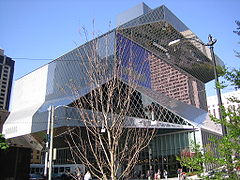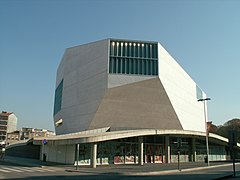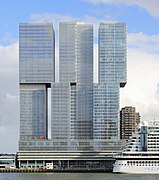|
Rem Koolhaas
Remment Lucas Koolhaas (Dutch pronunciation: [rɛm ˈkoːlɦaːs]; born 17 November 1944) is a Dutch architect, architectural theorist, urbanist and Professor in Practice of Architecture and Urban Design at the Graduate School of Design at Harvard University. He is often cited as a representative of Deconstructivism and is the author of Delirious New York: A Retroactive Manifesto for Manhattan.[1] He is seen by some as one of the significant architectural thinkers and urbanists of his generation, by others as a self-important iconoclast.[2][3][4][5] In 2000, Rem Koolhaas won the Pritzker Prize.[6] In 2008, Time put him in their top 100 of The World's Most Influential People.[7] He was elected to the American Philosophical Society in 2014.[8] Early life and careerRemment Koolhaas was born on 17 November 1944 in Rotterdam, Netherlands, to Anton Koolhaas (1912–1992) and Selinde Pietertje Roosenburg (born 1920). His father was a novelist, critic, and screenwriter. His maternal grandfather, Dirk Roosenburg (1887–1962), was a modernist architect who worked for Hendrik Petrus Berlage, before opening his own practice. Rem Koolhaas has a brother, Thomas, and a sister, Annabel. His paternal cousin was the architect and urban planner Teun Koolhaas (1940–2007). The family lived consecutively in Rotterdam (until 1946), Amsterdam (1946–1952), Jakarta (1952–1955), and Amsterdam (from 1955).[9][10][11] His father strongly supported the Indonesian cause for autonomy from the colonial Dutch in his writing. When the war of independence was won, he was invited over to run a cultural programme for three years and the family moved to Jakarta in 1952. "It was a very important age for me," Koolhaas recalls "and I really lived as an Asian."[12] In 1969, Koolhaas co-wrote The White Slave, a Dutch film noir, and later wrote an unproduced script for American soft-porn king Russ Meyer.[13] He was a journalist in 1963 at age 19 for the Haagse Post[14] before starting studies in architecture in 1968 at the Architectural Association School of Architecture in London, followed, in 1972, by further studies with Oswald Mathias Ungers at Cornell University in Ithaca, New York, followed by studies at the Institute for Architecture and Urban Studies in New York City.  Koolhaas first came to public and critical attention with OMA (The Office for Metropolitan Architecture), the office he founded in 1975 together with architects Elia Zenghelis, Zoe Zenghelis and (Koolhaas's wife) Madelon Vriesendorp in London. They were later joined by one of Koolhaas's students, Zaha Hadid – who would soon go on to achieve success in her own right. An early work which would mark their difference from the then dominant postmodern classicism of the late 1970s, was their contribution to the Venice Biennale of 1980, curated by Italian architect Paolo Portoghesi, titled "Presence of the Past". Each architect had to design a stage-like "frontage" to a Potemkin-type internal street; the façades by Costantino Dardi, Frank Gehry and OMA were the only ones that did not employ Post-Modern architecture motifs or historical references.  Other early critically received (yet unbuilt) projects included the Parc de la Villette, Paris (1982) and the residence for the Prime Minister of Ireland (1979), as well as the Kunsthal in Rotterdam (1992). These schemes would attempt to put into practice many of the findings Koolhaas made in his book Delirious New York (1978),[15] which was written while he was a visiting scholar at the Institute for Architecture and Urban Studies in New York, directed by Peter Eisenman.[16] Architectural theoryDelirious New YorkKoolhaas's book Delirious New York set the pace for his career. Koolhaas analyzes the "chance-like" nature of city life: "The City is an addictive machine from which there is no escape" "Rem Koolhaas...defined the city as a collection of 'red hot spots'."[17] (Anna Klingmann). As Koolhaas himself has acknowledged, this approach had already been evident in the Japanese Metabolist Movement in the 1960s and early 1970s. A key aspect of architecture that Koolhaas interrogates is the "Program": with the rise of modernism in the 20th century the "Program" became the key theme of architectural design. The notion of the Program involves "an act to edit function and human activities" as the pretext of architectural design: epitomised in the maxim form follows function, first popularised by architect Louis Sullivan at the beginning of the 20th century. The notion was first questioned in Delirious New York, in his analysis of high-rise architecture in Manhattan. An early design method derived from such thinking was "cross-programming", introducing unexpected functions in room programmes, such as running tracks in skyscrapers. More recently, Koolhaas unsuccessfully proposed the inclusion of hospital units for the homeless into the Seattle Public Library project (2003).[18] Project on the cityKoolhaas' next publications were a by-product of his position as professor at Harvard University, in the Design school's "Project on the City"; firstly the 720-page Mutations,[19] followed by The Harvard Design School Guide to Shopping (2002)[20] and The Great Leap Forward (2002).[21] All three books published student work analysing what others would regard as "non-cities", sprawling conglomerates such as Lagos in Nigeria, west Africa, which the authors argue are highly functional despite a lack of infrastructure. The authors also examine the influence of shopping habits and the recent rapid growth of cities in China. Critics of the books have criticised Koolhaas for being cynical,[22] – as if Western capitalism and globalization demolish all cultural identity – highlighted in the notion expounded in the books that "In the end, there will be little else for us to do but shop". Perhaps such caustic cynicism can be read as a "realism" about the transformation of cultural life, where airports and even museums (due to finance problems) rely just as much on operating gift shops. It does, however, demonstrate one of the architect's characteristic devices for deflecting criticism: attack the client or subject of study after completing the work. When it comes to transforming these observations into practice, Koolhaas mobilizes what he regards as the omnipotent forces of urbanism into unique design forms and connections organised along the lines of present-day society. Koolhaas continuously incorporates his observations of the contemporary city within his design activities: calling such a condition the ‘culture of congestion’. Again, shopping is examined for "intellectual comfort", whilst the unregulated taste and densification of Chinese cities is analysed according to "performance", a criterion involving variables with debatable credibility: density, newness, shape, size, money etc. In 2003, Content, a 544-page magazine-style book designed by &&& Creative and published by Koolhaas, gives an overview of the last decade of OMA projects[23] including his designs for the Prada shops,[6] the Seattle Public Library, a plan to save Cambridge from Harvard by rechanneling the Charles River, Lagos' future as Earth's third-biggest city, as well as interviews with Martha Stewart and Robert Venturi and Denise Scott Brown. Volume MagazineIn 2005, Rem Koolhaas co-founded Volume Magazine together with Mark Wigley and Ole Bouman. Volume Magazine – the collaborative project by Archis (Amsterdam), AMO and C-lab (Columbia University NY) – is a dynamic experimental think tank devoted to the process of spatial and cultural reflexivity. It goes beyond architecture's definition of ‘making buildings’ and reaches out for global views on architecture and design, broader attitudes to social structures, and creating environments to live in. The magazine stands for a journalism which detects and anticipates, is proactive and even pre-emptive – a journalism which uncovers potentialities, rather than covering done deals. Buildings and projectsIn the late nineties he worked on the design for the new headquarters for Universal.[24] Indeed, online marketing and propaganda has been a hallmark of OMA's rise in the current century. It has also led to pointed criticism, such as the critique by New York Magazine critic Justin Davidson, who found the 2020 Guggenheim exhibition Countryside, the Future "mildly amusing if it weren’t such terrible waste — of attention, of gallery square footage, of resources, talent, and expertise. Bored with being an architect and building things, Koolhaas lets his fingertips graze important topics, genuine insights, and actual lives. He treats them all as ironic bric-a-brac, meaningless souvenirs of his meanderings through a fragile world. How frustrating that the Guggenheim couldn’t force a little more intellectual rigor on this romp."[25] Architecture, fashion, and theatre With his Prada projects, Koolhaas ventured into providing architecture for the fleeting world of fashion and with celebrity-studded cachet: not unlike Garnier's Opera, the central space of Koolhaas' Beverly Hills Prada store is occupied by a massive central staircase, ostensibly displaying select wares, but mainly the shoppers themselves. The notion of selling a brand rather than marketing clothes was further emphasised in the Prada store on Broadway in Manhattan, New York,[6] which had previously been owned by the Guggenheim: the museum signs were not removed during the outfitting of the new store, as if emphasizing the premises as a cultural institution.[26] The Broadway Prada store opened in December 2001, cost €32 million to build, and has 2,300 square meters of retail space.[6] 21st-century projects Probably the most costly and celebrated OMA projects of the new century were the massive Central China Television Headquarters Building in Beijing, China, and the new building for the Shenzhen Stock Exchange. In his design for the new CCTV Headquarters in Beijing (2009), Koolhaas did not opt for the stereotypical skyscraper, often used to symbolise and landmark such government enterprises; he patented a "horizontal skyscraper" in the U.S. The building, popularly called "The Big Pants" by Beijing residents, was designed as a series of volumes which attempt to tie together the numerous departments onto the nebulous site, but also introduce routes (again, the concept of cross-programming) for the general public through the site, allowing them some degree of access to the production procedure. An unfortunate incident that highlighted the folly of the circulation scheme (no effective fire egress for people on the upper floors), was the construction fire that nearly destroyed the building and a nearby hotel in 2009.[27] In February 2020, his exhibition Countryside, The Future opened at the Guggenheim in New York City.[28] The exhibition closed within a month, after New York City closed all its major art institutions in connection with the COVID-19 pandemic. Personal lifeKoolhaas was previously married to Madelon Vriesendorp, an artist who is the mother of his two children, Charlie, a photographer, and Tomas, a filmmaker.[29] Koolhaas divorced Vriesendorp in 2012.[30] He has known his current partner Petra Blaisse, an interior and landscape designer, since 1986.[29][30] Selected projects
Bibliography
Gallery
See alsoReferences
External linksWikiquote has quotations related to Rem Koolhaas. Wikimedia Commons has media related to Rem Koolhaas.
|
||||||||||||||||||||













